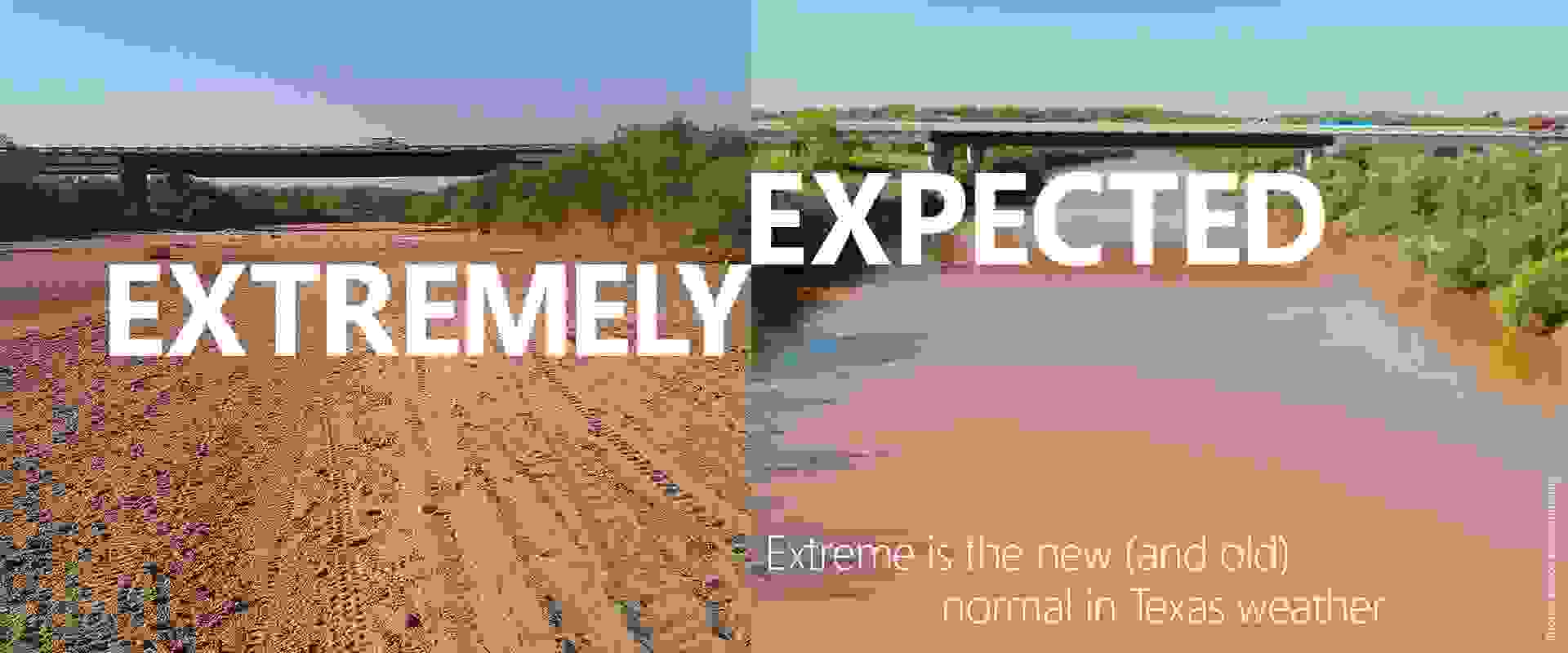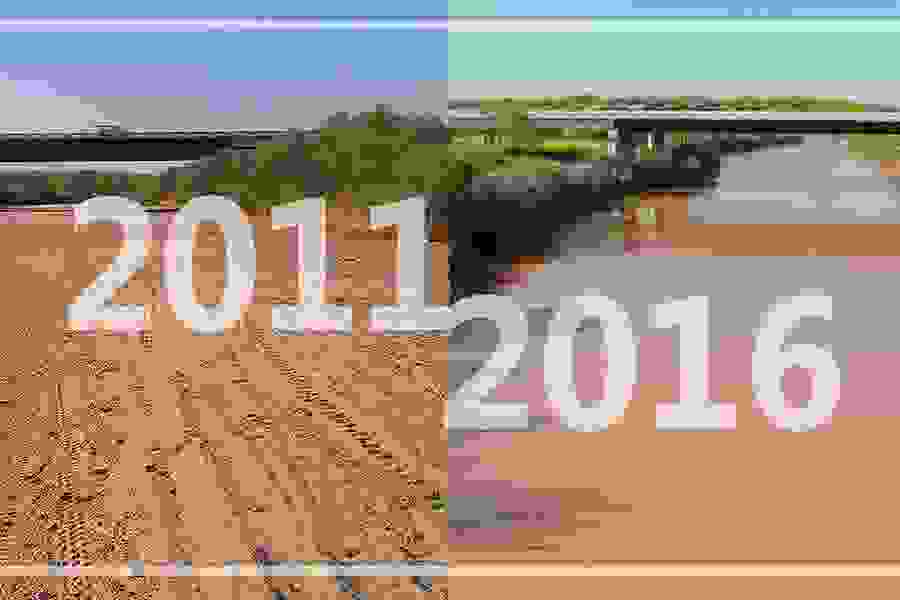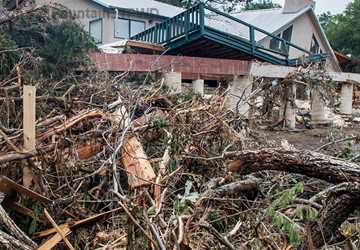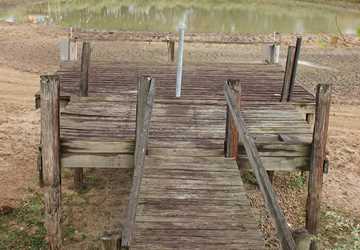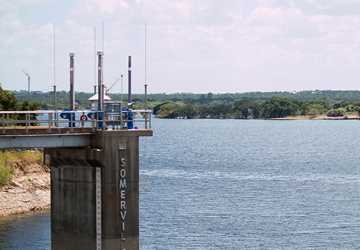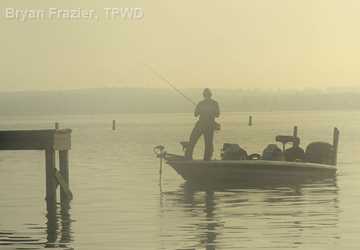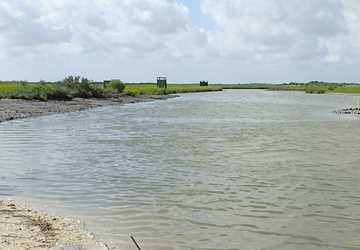In 2011 Texas experienced the driest year in its recorded history. 2015 was the wettest year on record with May 2015 the wettest month ever. Heading into fall 2016, experts were predicting a warm, dry winter.
Welcome to Texas weather.
This extreme variation in Texas weather is common, experts said.
Dr. Nelun Fernando, hydrologist for the Texas Water Development Board (TWDB), said historically drought and flood events in Texas do tend to follow each other. For instance, both the 1950s and the 2010-2015 droughts, and many other shorter duration drought events, ended in intense rainfall leading to flooding. “So, it is fair to say that is the norm,” she said.
State Climatologist Dr. John Nielsen-Gammon, Regents professor in Texas A&M University’s Department of Atmospheric Sciences, agreed that extreme weather changes are expected in Texas.
“I think it’s fair to say Texas weather is unusually abnormal,” he said. “We have a lot of variability in terms of rainfall, and also in the wintertime, temperatures vary a lot.”
Climate change expert Dr. Bruce McCarl agreed that Texas’ extreme weather is not new, although climate change will affect it.
I think it’s fair to say Texas weather is unusually abnormal. We have a lot of variability in terms of rainfall, and also in the wintertime, temperatures vary a lot.
“We’ve had a degree of variability for an awfully long time; in the end, we’ll have it for a long time in the future. It’s not purely a climate change phenomenon,” said McCarl, distinguished professor, Regents professor and Texas A&M AgriLife Faculty Fellow in Texas A&M’s Department of Agricultural Economics. “There are some rather major variability-causing things that come from the ocean, and climate change is likely to exacerbate that variability.”
Extremes explained
The state’s variable weather is caused, in part, because of its unique position globally. The state is at the crossroads of large-scale weather patterns, Nielsen-Gammon said.
“We’re one of the few places on the globe that is affected by what’s happening in both oceans,” he said. “Our rainfalls are affected in the wintertime fairly strongly by what’s happening in the Pacific Ocean. And in the summertime, there is a bit of an influence from the Atlantic Ocean.”
In the Pacific, El Niño — warm waters near the ocean’s center — and La Niña — cooler waters — influence Texas weather. El Niño and La Niña are phases of a recurring climate pattern across the tropical Pacific called the El Niño-Southern Oscillation, or ENSO. El Niño typically brings above-normal rainfall and below-normal temperatures to Texas during the cooler parts of the year. La Niña usually brings drier, warmer weather.
The La Niña pattern influenced the 2011 drought, Fernando said, causing reduced rainfall in late 2010 and early 2011. Nielsen-Gammon said predictions are that the state may have another La Niña in the winter of 2017.

“For a lot of the past few years, we’ve had both oceans working against rainfall in Texas at the same time and that helped contribute to the multiyear drought we experienced,” Nielsen-Gammon said.
It is still unclear whether Texas is getting out of the drought cycle that it’s been in for the past 20 years. “At this point, it’s wait and see,” he said. “But, it’s possible we’ve gotten to the end.”
Texas’ susceptibility to both extreme drought and floods is somewhat unusual compared to other states.
“In Arizona, for example, it’s sort of a permanent drought,” he said. “You can get flooding happening locally, but it’s not going to be anything major. In Vermont, you can get some pretty heavy floods, but you don’t tend to get severe droughts. Here you get both.”
Is extreme weather more frequent now?
Whether extreme weather in Texas is becoming more frequent remains to be seen.
Nielsen-Gammon said the state has seen more extremes than normal in recent years, but part of that is the randomness of weather. “For example, in May of 2015, we obliterated the statewide record for monthly rainfall, but the long-term trend for springtime rain in Texas is pretty much completely flat, so that doesn’t seem to be part of the trend,” he said.
Nielsen-Gammon said climate models do, however, predict a long-term upward trend in extreme rainfall events and temperatures for Texas. The warmer air over the warmer oceans will carry more water vapor to Texas, producing heavy rain.
His analysis of the past century shows a 20 to 40 percent increase in extreme rainfall. For example, a storm in late October 2015 produced the highest total rainfall amounts ever for one storm, he said.
Dr. Philip Bedient, Herman Brown professor of engineering in Rice University’s Department of Civil and Environmental Engineering, said Houston is indeed experiencing more frequent and more extreme rainfall events in recent years, leading to more frequent and devastating floods.
In May of 2015, we obliterated the statewide record for monthly rainfall, but the long-term trend for springtime rain in Texas is pretty much completely flat.
Houston has seen seven major floods in the last 15 years, compared to six in the 25 years before, he said. “When you start seeing two events, one was a 100-year flood event and the other much greater than 100-year, over a vast part of the county in less than a year, I don’t know if that has ever happened before,” he said.
The Dallas-Fort Worth Metroplex is also seeing more extreme amounts of rainfall, according to Dr. Dong-Jun Seo of the University of Texas at Arlington (UT at Arlington) Department of Civil Engineering.
“In North Texas, over the last 50 years or so, the rainfall amounts from heavy precipitation events have increased about 15 percent,” he said. “According to climate projections, the trend will continue and we may expect to see more extreme rainfall.”
But the models are not nearly as consistent with overall annual rainfall amounts, Nielsen-Gammon said. For the next few decades, the natural variability of Texas weather will be a much larger influence on overall rainfall than any long-term trend from climate change, he said.
“We don’t know how much of the monthly or annual rainfall variations we’ve seen so far are part of a long-term trend,” Nielsen-Gammon said. “But the temperature changes and the short duration rainfall amounts are pretty clearly part of a trend.”
McCarl agreed that while climate models are projecting hotter temperatures, the projections for annual rainfall for Texas are not as certain.
“If it gets several degrees warmer, there will be more evaporation that happens over the ocean, and that’s going to mean more total rainfall,” he said. “But most people think Texas is going to be substantially drier,” he said, citing Columbia University research showing that normal conditions in Texas by 2080 will be equivalent to those of the most recent drought. “That’s (the normal conditions) not drought; that’s just the average.”
McCarl said most climate models are projecting more extreme weather worldwide — more droughts, more floods, perhaps a higher frequency of hurricanes — with more severity.
“There have been some arguments made, although it’s not really settled, that El Niño and La Niña events would become more frequent, and more severe, so that would mean more frequent and more severe droughts in Texas,” McCarl said.
Future scene for Texas agriculture
A hotter Texas will change the agricultural industry and land use, McCarl said.
There will be more evaporation from reservoirs and less soil moisture, he said. “So even if it rains the same amount, agriculture production will suffer because of the drying soil moisture,” he said.
McCarl predicted a hotter Texas will see a conversion of crop land into grassland — as much as a 25 percent decrease in crop acreage — as well as a decline in livestock numbers. Studies show that livestock appetites will be depressed and there will be lower calving rates and higher incidents of various diseases as well as longer feeding periods to get the animal to an equivalent weight.
McCarl has also analyzed crop yields and crop yield variability in a changing climate. “We showed substantially more variable crop yields due to the fluctuating weather conditions, and for most crops, we show lower crop yields.”
McCarl said the state will need to figure out ways to adapt.
To maintain the past rate of yield growth, he said, the state would have to substantially increase its research investments.
“We need to make crops that can grow with less water, change our crop mix away from heavily water dependent crops, use water more efficiently and perhaps manage water a little better, so we would have lower evaporation losses and bigger supplies.”
Preparing for future conditions
Considering these predictions of a hotter, drier Texas that still sees extreme, flood-inducing rainfall events, what can the state do to manage resources and prepare for these extremes?
After the 1950s drought, Texas began tackling drought solutions by initiating a state water plan specifically to address water needs in times of drought. In the newly released 2017 plan, the 10th such plan, there are more than 5,500 water management strategies, which, if implemented, would provide 8.5 million acre-feet of additional water supplies per year by 2070.
On the heels of the driest year in the state in 2011, the Texas Legislature in 2013 passed and voters approved, the State Water Implementation Fund for Texas (SWIFT) program. Managed by TWDB, SWIFT provides state financial assistance for the water management strategies in the state water plan.
More recently, there has been more attention on possible solutions for flood preparedness and management.
For example, researchers at Rice University, UT at Arlington among others all developed more sophisticated flood alert systems to help alleviate damage or loss of lives. In addition, Texas A&M AgriLife Research scientists in Temple developed a flood alert system for Fort Hood and the city of Belton.

In November 2015, Gov. Greg Abbott transferred $6.8 million from the state’s Disaster Contingency Account to TWDB for development of better and more stream gauges and more technical assistance and outreach for floodplain management and planning. The board also developed Texasflood.org to provide flood information and resources to the public.
“Hopefully, the actions taken will pay off in terms of less damage or less life lost the next time we have extreme flooding,” Nielsen-Gammon said.
Dr. Robert Mace, TWDB’s deputy executive administrator for water science and conservation, said Texas does plan for both ends of the weather spectrum. “On the water planning side, we plan for a very severe drought. And then on the flooding side, we’re also planning for severe floods. Does that mean there aren’t going to be worse droughts than the drought of record? Or worse floods than the 100-year flood? No,” he said. “But, given that we are planning for those edges, it helps make us better prepared.”
For Mace the biggest issue is the complacency that happens between droughts and between floods. “People think that, ‘Oh, we just had a major five-year drought; that was a fluke. We won’t have one of those again for a while,’ and they get complacent,” he said. “But, almost assuredly we will.”
The same complacency happens about floods, he said, with people thinking, “that was a once in a 100- or 500-year flood, so we’ll never have to worry about that again.
People think that, ‘Oh, we just had a major five-year drought; that was a fluke. We won’t have one of those again for a while,’ and they get complacent. But, almost assuredly we will.
“In actuality, the statistics show that you will see that happen again,” Mace said. “So, the important part is to help people be prepared for those extreme events.”
The challenge to responding to Texas’ weather extremes, Nielsen-Gammon said, is that people must think outside the box.
“People often say the army is always preparing to fight the previous war rather than the next war,” he said. “Weather extremes are sort of the same way. We react to weather extremes when they happen. But it’s difficult to prepare for them, because we haven’t yet experienced the future extremes that will happen.
The truly extreme weather, the things that only happen maybe every 50 or 100 years, that’s beyond most people’s memory; they haven’t been able to see what the weather can do."
Explore this Issue
Authors
As the former communications manager for TWRI, Kathy Wythe provided leadership for the institute's communications, including a magazine, newsletters, brochures, social media, media relations and special projects.

